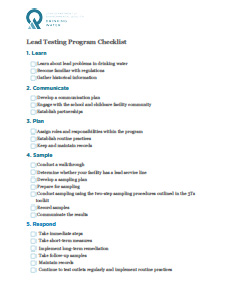
The 3Ts for Reducing Lead in Drinking Water in Schools provides tools for schools, childcare facilities, states, and water systems to implement voluntary lead in drinking water testing programs. The 3Ts rest on four key actions:
The Utah Division of Drinking Water (DDW) suggests that school and childcare facilities implement programs for reducing lead in drinking water as part of their overall plan for maintaining healthy learning environments. Safe and healthy environments foster healthy children and improve student performance.
Infants and young children are particularly susceptible to lead exposure, and drinking water can be a significant source. Negative health effects from lead exposure include behavior problems, learning problems, lower IQ, hyperactivity, slowed growth, hearing problems, and anemia.
Lead can enter a facility’s drinking water through plumbing materials such as pipes and solder. Testing is the only way for schools or childcare facilities to know if they have elevated lead levels in their drinking water.
WIIN Act Funding for Lead Testing
The Water Infrastructure Improvements for the Nation Act or “WIIN Act” of 2016 authorizes the Environmental Protection Agency (EPA) to establish a voluntary grant program to help schools and childcare facilities test for lead in their drinking water. Facilities that receive WIIN Act funding must utilize EPA’s 3Ts for Reducing Lead in Drinking Water in Schools and Child Care Facilities guidance or equivalent state program when implementing the plan.
Lead Testing Program Checklist

The first and most important step is to make a plan before sampling begins. EPA has assembled a 3Ts Toolkit to help schools and childcare facilities develop a plan and cultivate partnerships that support the implementation of the plan. Use the checklist to facilitate plan development.
Communication Plan
A communication plan is a core element of the 3Ts program. Communication supports community engagement and builds trust with parents, staff, and the public. Facilities that communicate early and often about sampling plans, test results, and next steps build confidence in the ability of each school or childcare facility to provide a safe learning environment for children. A comprehensive communication plan helps facilities:
- Communicate effectively with the community
- Ensure the information is honest, accurate, and comprehensive
- Speak with one voice
- Anticipate questions and concerns and address them proactively
- Keep their audience up-to-date as new information becomes available
EPA outlines a series of steps facilities can use to develop their communication plan:
- Get a team together.
- Create a contact list.
- Identify target audiences.
- Determine methods of communication.
- Identify the times to communicate and notify the public in advance.
- Communicate.
Training
Training helps school administrators, teachers, and staff learn more about the health effects of lead in drinking water and develop plans that provide the framework for an effective program. Training modules in the 3Ts program provide important information about:
- The health effects of lead, particularly for younger children
- Sources of lead
- How lead gets into drinking water
- The relationship between public water systems and schools and childcare facilities
- How lead in drinking water is regulated
Testing
Testing guidance provides important information to help schools and childcare facilities:
- Develop a sampling plan
- Identify sample locations
- Complete a Plumbing profile questionnaire
- Select a certified lab for sample analysis
- Develop a code system for samples
- Determine sampling frequency
- Conduct sampling
- Interpret results
Taking Action
Schools with lead levels above the action level can use a variety of methods to reduce levels and remediate the problem:
- Implement a flushing program and water usage plan to safeguard against lead exposure. This may include flushing faucets at sinks and/or water fountains, particularly after weekends and vacations, and limiting water consumption for food and beverage preparation to cold-water faucets.
- Replace faucets or other drinking water outlets found to be above the action level for lead.
- Clean water fountains, aerators, and screens.
- Physically disconnect faucets or plumbing with high levels of lead.
- Install a water treatment system.
- Post notices at faucets that are being investigated after a high lead result.

